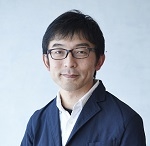Beyond Disasters - Telling the Stories <3>
Ishikura Toshiaki, Art Anthropologist, Associate Professor at the Akita University of Art, contributor
Rethinking Stories - From The Story of Ishi to "Cosmo-Eggs" (Part 1)
June 20, 2022
[Special Feature 074]
Special feature: Beyond Disasters - Telling the Stories (Special feature overview here)
Myths and history are passed down from generation to generation. How are these stories from the past told and updated, transforming them into stories that transcend time and place? And what feelings did anthropologist and mythologist Ishikura Toshiaki instill in his work, "Cosmo-Eggs", recreated for exhibition at the Japan Pavilion at the 58th International Art Exhibition - La Biennale di Venezia, based on his research of myths throughout the world? This is Part 1 of the article, followed by Part 2 in the next issue.
Rethinking Stories - From The Story of Ishi to "Cosmo-Eggs"(Part 1)
Ishikura Toshiaki
1. Overcoming the challenge of communicating experience
The act of telling another person about an experience may seem simple, but it is in fact quite difficult.
For example, in times of extreme crisis or when disasters or accidents occur around us, we hesitate in our attempt to describe what happened and are rendered speechless. The realities that we are unable to process are buried deep in our bodies and emotions, remaining only as subconscious memories. It is not uncommon for those who suffer through the horror of war, unexpected accidents, or disasters such as earthquakes or tsunami, to find themselves at a loss to speak of their experiences.
Even simply speaking of one's inner experience is often fraught with difficulties. And we are even unable to speak in appropriate terms of our own birth and death, surely the greatest events in our lives. The words we have in our possession arrive too late to speak of our birth, yet too soon to speak of our death. Thus, words are never able to keep up with these decisive events in our lives.
But yet we still try to recall our birth and speak of our death. We explore that dimension that cannot be verbalized, translate it into images and symbols, and exchange those with others. We never cease living and expressing our stories, filled with both pain and joy.
Be that as it may, the narrative forms of myth and history are utilized as the most important resources for understanding shared within a given society. The act of telling stories to each other involves listening while paying close attention to each other and sharing the real story behind the words. Perhaps the very difficulty of telling and sharing stories is what makes us respect them and listen to each other's voices.
These legends of shared ancestors and heroes, and the myths about the creation and destruction of the world, belong to the realm of the imagination and can no longer be verified by those of us living in modern society. But it is this very virtuality, an opening to the realm of the unknown, that connects our present to both the past and the future. Meanwhile, history is focused on verifiable records, rather than myth and legends, and the stories thereof are organized collectively according to the sequence of events. History, along with the coherent causes and effects of events from the past, affords us a deep insight into the present reality. But regardless, it is the narrative form that we follow when we share the events that occur in our world.
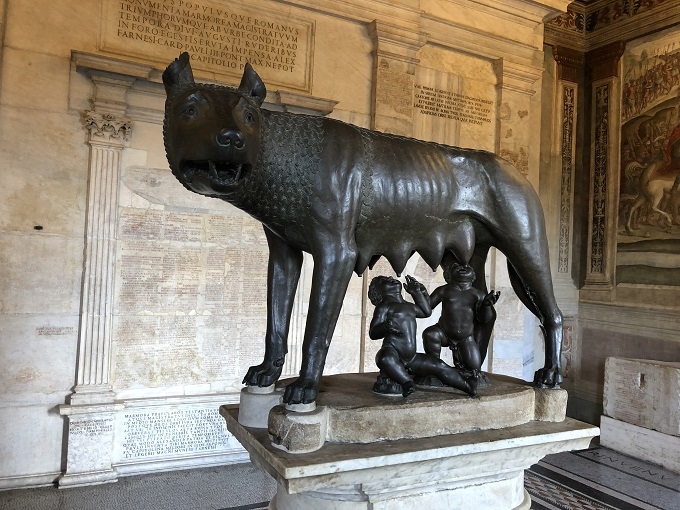 Capitoline She-wolf depicting Romulus and Remus suckling on the she-wolf, the Capitoline Museums, Rome.
Capitoline She-wolf depicting Romulus and Remus suckling on the she-wolf, the Capitoline Museums, Rome.It would not be an exaggeration to say that stories give value to our lives and integrate them into the social realm.
As Paul Ricoeur states in Time and Narrative *¹, stories are how we process the living experiences in time and make the unknowns of reality comprehensible. And the act of hearing or reading a story is to receive the meaning assigned to it, providing us with a framework through which we can act within reality. And by adopting the stories of others as models to imitate, and retelling those stories anew as our own, we create new prospects and perceptions even as we touch on the untellable, making it possible, in turn, to share these with others.
2. Stories that transcend cataclysm
Today, as countless conspiracy theories and fake news inundate much of the media on the Internet, one might be able to say that we are entering an age where, in a sense, history and myth intersect. This is a time in which there is an increasing tendency for us to listen to that which we want to hear, and shut out that which we do not. But unmistakably, this means that it is ever more necessary for us to understand the importance of story.
Following the Great East Japan Earthquake in 2011, countless people living in the Tohoku region of Japan were forced to spend sleepless nights in simple evacuation shelters and temporary housing. Many were the nights where intrusive noise afflicted the daily lives of the survivors, making it difficult even to rest. Many children in the disaster area became bereft of dreams, and their individual stories became lost. The history and memories woven by the communities in each place were left stranded in the villages destroyed by the earthquake and tsunami, and the glory and splendor of the Japanese cities, made possible by the many nuclear power stations built on unstable ground, was shattered to pieces. Many people rose up in response, reconsidered the faults in the stories they had previously told each other, and attempted to create a new society. But what filled the ensuing void, fueled by calls for reconstruction and restoration, was the sound of bulldozers come to build thick walls and roads amid the destroyed communities, burying the delicate memories that were once part of these people's beings under the dirt along with the mountains of rubble.
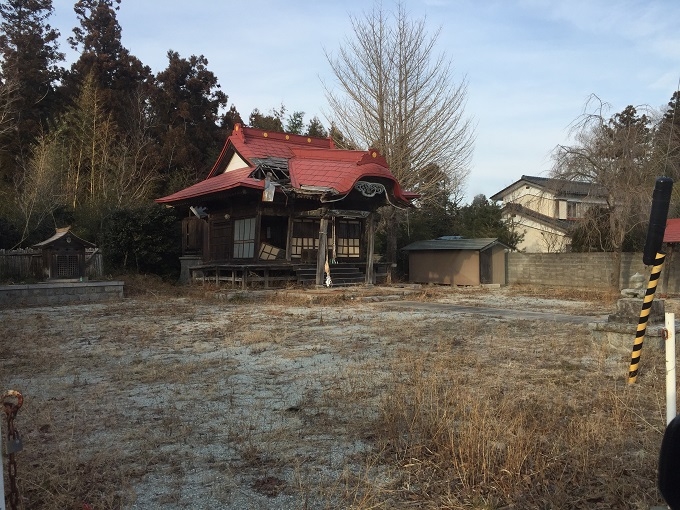 Damaged Shinto shrine / Namie, Fukushima Prefecture
Damaged Shinto shrine / Namie, Fukushima PrefectureTen years later, Japan today again faces a major cataclysm in the form of a pandemic caused by a new virus spreading throughout the world. To be sure, the natural disaster that occurred ten years ago destroyed countless communities at a great loss of life, dreams, and wealth. But what can also not be forgotten is that other cataclysm we call disaster capitalism that swept across those damaged communities, carried by the dreams of recovery. Plans arrived in these communities, together with budgets for the removal of contaminated soil and for the construction of massive seawalls, to build casinos, supermarkets, and brand new residential developments, all in the name of disaster recovery. Though ten years have passed, the grownups are still attempting to push through their opportunistic narrative that makes a protagonist out of the great urban centers, leveraging the Olympics and World Expos as massive parade floats to rally the people. But these stories of ambition, drenched in the smell of money and competition, are unlikely to touch the hearts and minds of children so easily.
Let us recall our childhood, a time when everyone was thirsting for stories.
Children take on the roles of the protagonists of stories and immerse themselves in the lives of others. At night, they shake their little bodies and beg for a bedtime story with newly acquired language, and by doing so, they are preparing for their voyage to the world of dreams. This world of dreams is a world governed by the tides of life, rich with the sounds of proliferating waves. It is a world of dense vision in which conglomerates of uncertainty appear and disappear. The stories told by grownups at their bedsides serve as rafts that carry them to this world, and before long, these children now beckoned to sleep have already begun rowing forth into the world of dreams that unfolds in their hearts, carried by the great wave of that which cannot be spoken.
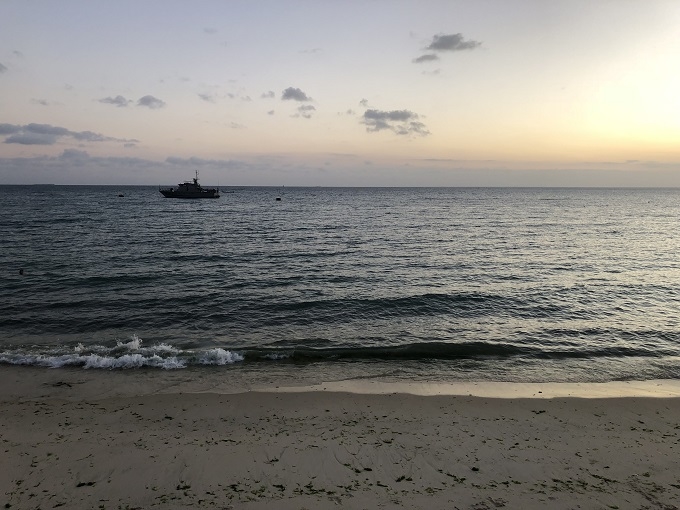 Sunset on Zanzibar / United Republic of Tanzania
Sunset on Zanzibar / United Republic of TanzaniaAs the rhythms of life and death press against the thin bottoms of the story vessel, the children listen intently even through the gentle breath of slumber. Will the children be able to complete their voyage tonight? In the world of dreams, it is the children who must take the helm. Reality is transformed in dreams in a manner more magical than any experience these children will encounter in their lives, as the very meaning of things becomes unshackled, losing all identity of self. But the children do not pause at these irrational occurrences. Rather, they give themselves to the flow, and learn another meaning to the world that cannot be experienced in waking reality. What are the stories that we can tell to our children now?
3. Recreating stories
Alfred Kroeber, one of America's foremost cultural anthropologists, was known to have enjoyed taking the myths and legends of the Native American peoples he learned from his informants, and retelling them to his small daughter in deliberate and easily understood English. The mother of that daughter, Theodora Kroeber, was also a writer and anthropologist, as well as an excellent storyteller who communicated the memories of the last Native Americans of California who were facing extinction.
The stories they told were the stories of the tribes, passed down in the midst of the unspeakable tragedy of certain extinction, the result of the persecution and genocide by the white man. The daughter of these two anthropologists, who researched those myths in order to pass them down to later generations, was none other than Ursula Kroeber Le Guin, known throughout the world today as the author of such stories as The Earthsea Cycle and The Left Hand of Darkness.
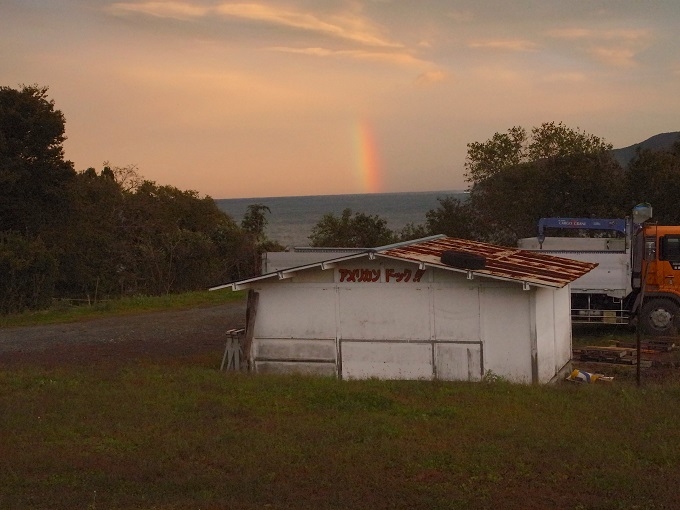 Seaside rainbow / Kamaishi, Iwate Prefecture
Seaside rainbow / Kamaishi, Iwate PrefectureUrsula was raised in an environment in which she was exposed to numerous folktales, myths, and legends from childhood, alongside the living tales she heard from her parents. Then at the age of twelve, her discovery of a copy of A Dreamer's Tales by Lord Dunsany (Irish author, 1878-1957) on the family's bookshelf served as a decisive experience which made her aware of the world of stories. Myths shine light on the realities hidden within our world and teach us that the time we spend in this world is not fragmentary, but part of a continuity that stretches between the beginning and the end. Her discovery of Lord Dunsany taught her that these myths were not something relegated to the past, but something that adults in today's world continued to create. She wrote in this regard, "What I hadn't realized, I guess, is that people were still making up myths." *² Surely her discovery of A Dreamer's Tales opened an unexpected doorway to the possibilities of creating new mythical stories within her own heart.
Good fantasy evokes a dialogue between the adult in the child and the child in the adult.
One other author which greatly influenced Le Guin was her own mother, Theodora.
Just as Le Guin, now an adult, became a mother herself after marrying a historian she met while studying abroad, her mother Theodora Kroeber was in the process of finishing her valuable work as the inheritor of stories.
In the late 1950s, Theodora began to reconsider the myths and legends she had learned from the indigenous societies along the Klamath and Columbia river basins which she had once studied with her husband, and she was beginning unique research on the origins thereof. For example, the story Loon Woman shared by eight tribes of Native Americans from Northern California, each speaking a different language, contains a tragedy of incest not unlike the Greek myth of Oedipus, but the act occurs not with the mother but between brother and sister. Theodora explains the circumstances of the tribes which passed down this tale and the natural environment in which they lived, and then goes on to examine, through her own creative output, the secret to creativity which gave rise to multiple versions of the story through individual imagination. *³ Theodora examined the existing Native American myths by retelling those stories familiar to her in her own words, but she also demonstrated in an experimental manner the transformative process by which new versions of those stories are created.
For her work Inland Whale, published in 1958, Theodora selected nine stories from among the legends known to the Native Americans of California that particularly featured female protagonists and retold them in her own words. For example, she has the following to say about the nature of the story The Man's Wife passed down by the Yokut tribe.
The raw material from which are spun the tales that live to be told and retold to children and grandchildren is usually primitive in that it is the concretization of something arising from the unconscious: a love, a hate, a longing, a fear, a question. And if the tale is so well spun that the love is realized, the hate avenged or dispersed, the longing assuaged, the fear generalized and shared, or the question answered, then the author, the teller, and the audience, whether Yokuts or Greek or modern American, are functioning on a level not primitive nor necessarily sophisticated, but wholly human, which functioning I take to be an early aspect of art. *⁴
Here, she vividly explains the secret phenomenon by which stories are shared, where the retelling of the tales enables one individual to touch on the reality experienced by another, going beyond ethnicity or language.
The important thing is that the "early aspect of art" which she speaks of here clearly occurred not only within those who were the subjects of her research, but also within herself. And it is not difficult to imagine that the many stories passed down by Theodora in her own voice were picked up in spirit by her daughter, Ursula Le Guin, breathing life into her creativity in a new artistic domain.
- *¹ Paul Ricoeur, Jikan to Monogatari [Time and Narrative], vols. 1 and 2, translated by Kume Hiroshi (Tokyo: Shinyosha, 1987)
- *² Ursula K. Le Guin, Yoru no Kotoba: Fantasy SF Ron [The Language of the Night: Essays on Fantasy and Science Fiction] translated by Yamada Kazuko (Tokyo: Iwanami Shoten), 12.
- *³ Nakao Hajime, "Yakusha Atogaki" [Translator's Afterword] in Nairiku no Kujira: Kariforunia Indian no Densetsu kara no Kokonotsu no Saiwa [The Inland Whale: Nine Retellings from California Indian Legends] by Theodora Kroeber, translated by Nakao Hajime (Kyoto: Editorial Group SURE, 2017), 225-253.
- *⁴ ibid, 119.
Continue with Rethinking Stories - From The Story of Ishi to "Cosmo-Eggs" (Part 2)
Submitted July 2021
All photos by the author
Related Articles
Back Issues
- 2022.7.27 Beyond Disasters - T…
- 2022.6.20 Beyond Disasters - T…
- 2021.6. 7 Contributed Article …
- 2021.4.28 Crossing Borders, En…
- 2021.4.27 Contributed Article …
- 2021.4.20 Contributed Article …
- 2021.3.29 Contributed Article …
- 2020.12.22 Interview with the R…
- 2020.12.21 Interview with the R…
- 2020.11.13 Interview with the R…


